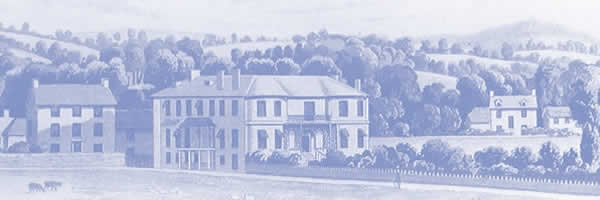History
History
- The house and its setting
Kennaway House is a fine Regency mansion built in 1805 (Listed Grade II*) standing at the heart of Sidmouth. It forms part of a quiet residential neighbourhood of houses and cottages of similar date. Early prints show two garden fronts, both of which have remained green spaces. A tree-lined drive leads up to the main entrance, while towards the west lies a putting green and beyond that croquet and cricket grounds, over which the house looks out to the sea.
- "A handsome brick house"
Contemporary guidebooks of the 1810s-1830s describe Fort House, as it was then known, as "a handsome brick house" and "a large house, very tastefully furnished". It had "a view of the town and sea", and "is now one of the most substantial and finished houses in Sidmouth". The house retains many of the features that inspired these descriptions: well-proportioned bow windows and pillared porches and the main entrance approached by a flight of steps. A verandah with curved canopy over the second entrance is characteristic of Sidmouth's Regency houses. Stained glass, which ornaments several of the windows, was an expensive novelty in domestic architecture at the time.
- A brief history
Originally a family home, the house was leased or rented as Sidmouth became a magnet for visitors, but by the 1890s it had become a lodging-house. Generous benefactors halted this decline. At the beginning of the last century, the house was purchased and endowed as "Church House" to serve the social activities of the parish. Following the First World War, a long period of financial difficulties began. At the turn of the millennium, a new board of trustees set about the task of raising £1 million for a comprehensive restoration to allow "Kennaway House" (the name chosen by popular vote) to serve the needs of the whole community once again.
- Sir James Amyatt, Captain Phillipps and the building of Fort House
On the manor tithe map of 1789 Sidmouth clusters by the sea, a fishing village surrounded by fields. But during the period of the Napoleonic wars (1793-1815), this small settlement expanded rapidly on the western side to become a fashionable resort for the gentry and aristocracy.
Sir James Amyatt, MP for Southampton, was a prominent landowner in this area. Among his assets were his two daughters and co-heiresses Charlotte and Harriet. It was through Harriet's marriage that Fort House came to be built, and through Charlotte's that the Kennaway family, a rising local dynasty, came to possess the house. Sir James gave a parcel of land to Harriet's husband, Captain Thomas Phillipps, perhaps as part of her marriage settlement, and on this land in 1805 Captain Phillipps built his house.
But by 1815 both Captain Phillipps and Sir James Amyatt, who had also been living in Fort House, were dead. Phillipps had bequeathed to "my present dear wife Harriett" among other items "the use of all my Plate Linen China Glass and Household Goods which shall be remaining in my dwellinghouse at Sidmouth" till his son Thomas came of age (possibly in 1819). What could be more convenient than that the house should be leased to the Kennaway family, into which Harriet's sister Charlotte had married? One of them was already Thomas's guardian.
The Kennaway Connection
- Building a business
The arrival and rise of the Kennaway family illustrate a period of mobility, both geographical and social. In 1713 young William Kennaway, a serge maker from Scotland, arrived in Exeter to practice his trade in this prosperous town. His son, also William, joined him and between 1750 and 1790 built up a very successful business in the woollen trade. But the Napoleonic wars spelled disaster for exports and the wool trade collapsed. Another William, in the third generation, turned instead to the wine trade, while his brothers John and Richard sought their fortunes in the east.
- Careers in India
John Kennaway left home in 1772, at the age of fourteen, to make reputation and wealth with the East India Company. Diplomacy, linguistic skills and lobbying of influential people led to his appointment as Aide de Camp to the Governor General, Lord Cornwallis, in 1786. As first British resident at the court of the Nizam of Hyderabad, he secured significant rights for the company, and was rewarded with a baronetcy in 1791. Richard Kennaway also acquired a fortune in his career with the Board of Trade in Bengal.
- Rewards at home
In 1793 Sir John left the East India Company and the brothers returned to England needing a home and family in keeping with their newly established wealth and status. In 1794 they bought the Escot estate near Ottery St Mary and in 1797 Sir John married Charlotte Amyatt. One source suggests that her father Sir James had also had business interests in India, possibly making the acquaintance of the Kennaways through these.
- An establishment in Sidmouth
In1808 Escot House was destroyed by fire: a candle in a dressing room set fire to the curtains and within hours the whole house was gone. The Kennaways had another property at Fairmile, but perhaps hankered after the social life and amenities of the newly developing watering-place of Sidmouth, and in 1815 Richard took a lease on Fort House. How it passed into the hands of Sir John is not yet clear, but contemporary sources tell us that he "greatly enlarged and beautified" the house and that by his death in 1836 he was "the proprietor of several houses in this place". Even after Escot was rebuilt, the Kennaways continued to use Fort House, and it is said that several of John and Charlotte's eleven children were born here.
- Letting to the gentry: tenants in Fort House and Aurora House
Letting houses for anything from a few months to years was common in Sidmouth at this time. The beautiful crescent of Fortfield Terrace was one of the earliest examples of speculative building intended for leasing.
After Sir John's death in 1836 various tenants lived in the house, their names revealed to us from 1841 by the census returns, which make it apparent that by the middle of the century Aurora House, adjacent to Fort House and under the same roof, was a separate property (it remains so today). Some of these tenants spent years, indeed decades, in the house. The census returns for 1841, 1851 and 1861 reveal that James Blencoe, clergyman, with five (or later four) servants lived there, and the same Rev James Blencoe is mentioned as residing there in "A descriptive sketch of Sidmouth" by Theodore Mogridge, as early as 1836.
Previous Residents
- From family tenants to lodging-house, and a local scandal
The Kennaways had been trying to sell the house from at least 1876, but it was not until 1879 that it was bought by William Hine Haycock, a solicitor who had retired to Sidmouth and owned Belmont, another Regency house. However, by 1888 he had decided to move to London and another long process of attempting to sell followed.
By 1891, the house seems to have deteriorated into a boarding house, as the census returns show. It was occupied by Daniel Hook and his wife (fisherman and lodging-house keeper, with two servants), and the current lodgers were Elizabeth Symes and her sister (occupying three rooms) and Francis Field and his son (two rooms). In 1901 Sarah and Susie Searle were recorded as lodging-house keepers, but in May 1904 the local paper reported "a meeting of the creditors of Miss Sarah Ann Searle, late of Fort House" attended by six out of her forty creditors, who reluctantly agreed to settle for "9/3 in the £".
- Edwardian benefactors: the founding of Church House
Mr Hine Haycock died before a purchaser for Fort House could be found, but in 1905 the trustees of his estate took a brave and unusual step. In spite of a higher offer from a property developer, they sold Fort House to Mr Richard Wood for £3,170. As the third Sir John Kennaway said in an address in 1906, "That house had always been a great feature of Sidmouth and if it had been pulled down to make way for rows of modern houses it would have been a great loss to the town".
Richard Wood and his wife came to Sidmouth from Rugby in 1896. They had been great benefactors to their native town and continued their generosity towards their adopted one, funding projects varying from the purchase and gift to the town of the land that is now Blackmore Gardens to the provision of Sidmouth's first steam fire engine. Mr. Wood had made his money largely through partnership with his wife's brother in an iron merchants' business in Manchester. Mrs. Elizabeth Hatton Wood was wealthy in her own right: the Sidmouth Observer mentioned a sum of £83,478 left after her death in 1904, and shortly after that, recorded the bequest of "the handsome sum of £500 to the Sidmouth Victoria Cottage Hospital" and "£100 for distribution among the poor of the town".
In 1906 the house changed both its purpose and its name. In accordance with his late wife's wishes, Mr. Wood not only purchased the property, but refurbished and endowed it. The new name reflected Mrs. Wood's concern that Sidmouth did not have a place for the social activities of the parish: to quote Sir John Kennaway again, "For the lack of a building like that there were...many young fellows who went to the bad..." The name, however, did not mean that the house belonged to, or was financed by, the church.
- Church House in the twentieth century
A board of trustees administered the building, but the activities of a unit of Territorial Cyclists for whom the house was requisitioned in the First World War, combined with massive storm damage in 1930, caused the chairman to lament that "the income is hardly sufficient for the necessary upkeep." This was to be a constant theme throughout the twentieth century.
Matters came to a head in 1999, when the trustees commissioned a survey which disclosed that the house needed such extensive repairs (eventually costed at £1 million) that its closure to public usage, and disposal for development, seemed inevitable.
The Restoration
- The Restoration Project
New trustees were appointed to try to save the building and, in late 2004, the Heritage Lottery Fund (HLF) provided an initial grant towards the cost of drawing up detailed renovation plans. Following public consultation, a full set of proposals was submitted to the HLF, which, in 2006, awarded a further grant of half the cost of the restoration project.
The trustees were delighted to receive further funding from several charitable trusts and individuals as well as the Town, District and County Councils and the Friends of Church House, who kept the project in the public eye through its vigorous programme of fundraising activities.
The local newspaper, the Sidmouth Herald, conducted a ballot among its readers to choose a new and more appropriate name for the building and, in August 2007, Church House became Kennaway House.
With funding in place, the £1 million programme of restoration work began in spring 2008 and Kennaway House was formally opened by the MP for East Devon, Hugo Swire, on 4th July 2009.
- Sidmouth & the Heritage Coast
Kennaway House is superbly situated within a short walk of the town centre of the much-admired coastal resort of Sidmouth. The town is well known as an attractive and friendly seaside community set in beautiful rural surroundings. Sidmouth combines a fine architectural heritage, with a number of high quality hotels, and a shopping centre characterised by individual, often independently owned, shops.
Particular features of the town are the delightfully unspoilt Esplanade and the numerous public open spaces and gardens that have made Sidmouth a regular winner of Britain in Bloom awards. The environs of Kennaway House are especially impressive, almost unaltered for two hundred years, and replete with listed buildings.
Sidmouth is set within an Area of Outstanding Natural Beauty, and is one of the premier towns on the renowned Jurassic Coast, a World Heritage site and an inspiring stretch of coastline. Turner painted Sidmouth, and the town has an enviable literary tradition, with Jane Austen, Elizabeth Barratt Browning, Thackeray, Beatrix Potter and Betjeman among its admirers. Many were drawn to the town by its benign micro-climate which is characterised by mild winters, warm summers with pleasant sea breezes and low rainfall.
Sidmouth is a welcoming town with a thriving hotel and business community that takes pride in its reputation for service and friendliness. For further information, go to www.visitsidmouth.co.uk.



